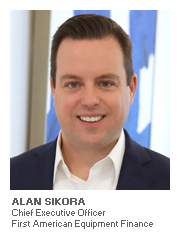
In mid-April, the Equipment Leasing & Finance Foundation (Foundation), released its Q2 update to the 2023 Equipment Leasing & Finance U.S. Economic Outlook, indicating that equipment and software investment growth slowed in the early months of 2023, resulting in the Foundation lowering its annual forecast for investment growth to 1 percent. The report also predicts sluggish economic growth in the first quarter of 2023 as the economy moves closer toward a recession – which the Foundation continues to expect will begin during the second half of 2023. Overall, annualized economic growth is forecast to be 0.7 percent in 2023.
Equipment Finance Advisor met with three industry leaders representing a cross-section of the equipment finance industry including Alan Sikora, CEO of First American Equipment Finance (Bank-owned), Hollis Bufferd, CEO of Star Hill Financial (Independent) and Jayma Sandquist, CMO & SVP US/CA, John Deere Financial (Captive), to provide their thoughts on the newest report and where the equipment finance industry may be heading in 2023.
We began by asking our participants to describe their view of the current economic environment, and if they agree with the Foundation and various economists that the U.S. economy will likely experience a recession in 2023.

“It seems that the current economic conditions in the U.S. continue to face challenges,” said Hollis Bufferd. “The Foundation lowering its annual forecast for investment growth to 1 percent suggests that companies may be cautious about spending and expanding operations, resulting in less opportunities for equipment financing. Businesses that did see growth in the first quarter were probably riding a wave from the fourth quarter of 2022 into early 2023. The Foundation’s expectation of a recession in the second half of 2023 is in line with the predictions from various financial experts who have been suggesting an economic downturn due to rising inflation, rising interest rates, continued supply chain disruptions and worldwide political tensions. It is important to note that this forecasting is not a science, and as we have seen in the past, there are many other variables that that can affect the economy.”
Alan Sikora said, “There is much uncertainty in the economy, resulting in an economic outlook that is as complicated as it has been in recent years. Our current thinking is consistent with many economists that a mild recession will most likely occur in the second half of the year.”

We also addressed the Foundation-Keybridge U.S. Equipment & Software Investment Momentum Monitor, which is released in conjunction with the Economic Outlook, and tracks numerous equipment and software investment verticals. According to the most recent Momentum Monitor two sectors are expanding, two are recovering, and eight verticals are weakening. For example, the report indicates “Trucks investment growth is likely to sidewind,” while “Materials handling equipment investment growth may pick up slightly.” We asked our panelists for their views on equipment financing demand in the first quarter of 2023 and if any sectors stood out for their companies.
“It is difficult to predict which sectors will see growth and which will decline. I think like everyone else, there was a panic in March of 2023, and our quarter did not end as strong as we anticipated, but we also continued to expand and invest in our people and specific sectors. Our team at Star Hill is more credit driven versus asset driven – providing different verticals to add to our portfolio, which has given us the opportunity to branch into areas outside of traditional equipment finance. Based on this diversification, we are poised for a record-breaking Q2,” said Bufferd.

Jayma Sandquist said, “There continues to be strong demand for agricultural and construction equipment into 2023. For the last several years customers have had a very strong cash position, so some finance penetration has been impacted by cash. Additionally, over the last 12 to 18 months, we saw very aggressive competitive financing offers from small- to medium-sized regional banks that had solid deposits at low rates and were able to offer very attractive lending rates to the market. Since the collapse of a few U.S. banks in March, small- to medium-sized banks have seen an outflow of deposits and we have seen less competitive offers from this segment of competitors.”
Challenges in the labor market also continue in the U.S. and these challenges have stressed many small and mid-sized businesses resulting in increased investment in equipment and technology. We were curious to learn if our participants have seen a rise in such investments – equipment and technology – to overcome current and anticipated labor shortages.
Sikora said, “There continues to be a trend toward financing capex investments in technology, automation and robotics, particularly in the manufacturing sector where labor shortages continue.”
“One of the key problems for agriculture and construction customers is access to and cost of labor. Technology in equipment that changes the labor requirements is certainly something that customers are keenly interested in," according to Sandquist.
Bufferd added, “I believe all industries including equipment finance are dealing with an experience gap. Having to pivot training to a hybrid and sometimes fully remotely experience has added to this conundrum, so yes, finding experienced employees remains difficult for small and mid-sized organizations. However, there are also opportunities to acquire talent from organizations that are downsizing and even eliminating financing programs due to the turbulent economy.”
The turbulent economy and the recent issues in the regional banking sector have also caused many analysts to predict a tightening of credit among regional banks. This tightening is already evident to Bufferd who said, “We have already seen a tightening of credit due to the issues with regional banks and this is most likely going to continue, but historically we have always seen a bounce back. It’s just difficult to determine when this will occur.”
Sandquist added, “I can’t speak to whether regional banks are tightening their credit yet, but we have certainly seen less aggressive financing offers from regional banks in the market since March.”
The Foundation produces the Equipment Leasing & Finance U.S. Economic Outlook report in partnership with economic and public policy consulting firm Keybridge Research. The Q2 report is the first update to the 2023 Economic Outlook and will be followed by two more quarterly updates before the publication of the 2024 Economic Outlook in December.
This data is highly valued in the industry and is utilized by many companies in developing their market strategies. This was echoed by Sandquist who said, “We have excellent economic resources at our parent company that we rely on as a trusted source for insights in the markets we compete in. The Foundation’s economic outlook is another source we can use to better understand what others are seeing in the financial services space.”
Readers may access the Q2 Report here.
Readers may also download the Momentum Monitor here.